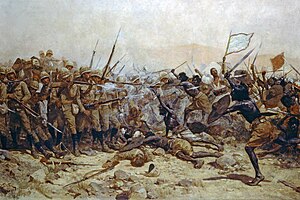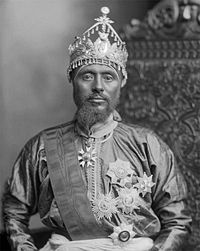Sougoulie: Difference between revisions
| Line 71: | Line 71: | ||
===Baséland=== | ===Baséland=== | ||
[[File:Ras_Mäkonnen_(Wäldä-Mika'él)_(1852-1906).jpg|200px|right|thumb|Amsalu in 1880, in traditional high-ranking Yebase dress.]] | [[File:Ras_Mäkonnen_(Wäldä-Mika'él)_(1852-1906).jpg|200px|right|thumb|Amsalu in 1880, in traditional high-ranking Yebase dress.]] | ||
While a major revolt that could be categorised as part of the Sougoulie never occurred in the colony of Baséland (now [[Garambura]]), many underground resistance groups secretly pledged their allegiance to those fighting in the Sougoulie, particularly the resurgent Verizi Empire, and arranged for their undocumented transportation into [[Mambiza|Sainte-Germaine]]'s outer bounds, where population documentation was rare. As the population in Baséland was so heavily concentrated around the coastal city, owing mainly to the [[Adunis | While a major revolt that could be categorised as part of the Sougoulie never occurred in the colony of Baséland (now [[Garambura]]), many underground resistance groups secretly pledged their allegiance to those fighting in the Sougoulie, particularly the resurgent Verizi Empire, and arranged for their undocumented transportation into [[Mambiza|Sainte-Germaine]]'s outer bounds, where population documentation was rare. As the population in Baséland was so heavily concentrated around the coastal city, owing mainly to the [[Adunis-Sainte-Germaine Railway]], a revolt at the level of the Sougoulie was unfeasible, with dissidents of the Eucleans realising the fact quickly. | ||
While some chose to travel to [[Mabifia]] and [[Rwizikuru#Colonisation|Riziland]] to fight alongside the Sougoulie rebels, most stayed in the colony, fearing for their lives and the lives of their families. Some still chose to show their solidarity by assisting the rebels in a logistical sense, with supplies often being stolen at the port of Sainte-Germaine and sent along a network of rebel-organised transporters until they reached rebel hotspots. Perhaps the most well-known and largest sign of resistance from Garambura was [[Yebase]] ship commander [[Alphonse Amsalu]]'s sinking of the ''NSM Insulaire'' in November 1883, a Gaullican supply ship carrying military supplies to fighting soldiers in [[Mabifia]]. Amsalu fired on the unexpecting ship, sinking the ship itself, its 105 crew and all of its supplies, he was sentenced to death for 105 counts of murder and treason in Sainte-Germaine in 1884, but is a well-known folk story in Garambura detailing heroism and resistance against opression. | While some chose to travel to [[Mabifia]] and [[Rwizikuru#Colonisation|Riziland]] to fight alongside the Sougoulie rebels, most stayed in the colony, fearing for their lives and the lives of their families. Some still chose to show their solidarity by assisting the rebels in a logistical sense, with supplies often being stolen at the port of Sainte-Germaine and sent along a network of rebel-organised transporters until they reached rebel hotspots. Perhaps the most well-known and largest sign of resistance from Garambura was [[Yebase]] ship commander [[Alphonse Amsalu]]'s sinking of the ''NSM Insulaire'' in November 1883, a Gaullican supply ship carrying military supplies to fighting soldiers in [[Mabifia]]. Amsalu fired on the unexpecting ship, sinking the ship itself, its 105 crew and all of its supplies, he was sentenced to death for 105 counts of murder and treason in Sainte-Germaine in 1884, but is a well-known folk story in Garambura detailing heroism and resistance against opression. | ||
==Aftermath== | ==Aftermath== | ||
Revision as of 21:45, 27 December 2019
| Sougoulie | |||||||
|---|---|---|---|---|---|---|---|
| Part of Toubacterie | |||||||
 Ndjarendie soldiers under Saïkou Ahmed Bamba clash with Gaullican troops during the Battle of Ourafade | |||||||
| |||||||
| Belligerents | |||||||
|
Template:Country data Estmere |
Soubaka Dominion of Heaven Kambou Karanate Ichïamba | ||||||
| Commanders and leaders | |||||||
|
Crumpet dude Sausage dude |
Saïkou Ahmed Bamba Fatima Maal Jean-Paul Rugima | ||||||
| Strength | |||||||
|
Template:Country data Estmere 13,000 | 200,000 | ||||||
| Casualties and losses | |||||||
| 2,000 | 100,000 | ||||||
The Sougoulie was a major unsuccessful revolt against Euclean colonisation in Bahia that took place in 1883 and 1884. It began in Meyrout, which was used by the Gaullicans as a garrison point for their Tirailleurs Bahiens, on the 23rd of May 1883 after the local garrison mutinied in revolt against the Act of Bahian Quartering Reform. As news of the revolt spread, other localised revolts broke out across the subcontinent. These revolts aimed to bring back the return of local rule and often resulted in the reformation of previously existing Houregic states, posing a threat to Euclean control over the region. The revolts were eventually defeated in 1884, following the defeat of the Soubaka Dominion of Heaven under Saïkou Ahmed Bamba. The name of the event is contested by historians as while the Bahian name of Sougoulie is widely accepted in Bahia, Euclean scholars disagree on the magnitude of the revolts. As such, the terms Bahian Mutiny, Tirailleur Mutiny and Bahian Rebellion of 1883 are also used. The term Sougoulie somes from a Ndjarendie root word for a meal taken before sunrise, which characterises the revolts as a first taste of freedom before the Kaoule.
While the catalyst cause of the Sougoulie was quartering reform within the Gaullican army, the revolts soon took a broader aspect of resistance against the cultural and religious repression of Bahian society by their Euclean colonisers as well as the economic expropriation of lands and resources by Euclean corporations. While many Bahians, particularly amongst the marginalised Irfanic and Fetishist pupulations, joined the revolts, many Sotirian Bahians instead fought alongside the Eucleans. The Sougoulie was a period of intense violence, particularly against the civilian population. Both sides were reported to have perpetrated massacres, with the Gaullican sack of Kambou being one of the most well-known examples.
In most cases, the revolts constituted a reactionary effort to reinstitute Hourege and the status quo before Toubacterie. There was not any major effort to cooperate between the different rebel groups, who often fought amongst themselves as well as fighting the Euclean forces. This division of resistance essentially doomed the revolts to failure, as they were unable to cross ethnic or religious lines against a common enemy and could therefore be defeated one by one. This failure was a key inspiration in the development of Pan-Bahianism, as the importance of a united struggle against colonialism was demonstrated.
Origins
During the Woundic period the Euclean colonisation of Bahia cemented itseld not only as a form of economic hegemony but of direct political control over the subcontinent.
- Missionaries
- Expropriation of land for Murungu
- Destruction of Fetishism
- Irfan discriminated
- End of caste system
- Anger against Euclea
Outbreak
Bahian divisions
The Revolts
Soubaka
Kambou
Ichïamba
Verizi Empire
As Estmerish forces continued advancing into the Plateau, the native villages in the Plateau realised that continuing the village system would inevitably mean that each village could be annexed into the Estmerish colony of Riziland. Thus, in 1881, the chieftains of the villages met in Munzwa to establish a neo-veRwizi Empire, known as the Verizi Empire, with the chieftain of Munzwa, Tamutswa being named Mambo of the Verizi Empire.
When word of the Sougoulie spread to the Plateau, Tamutswa called for all veRwizi chieftains to join the rebellion to "expel the Murungu" from Rwizikuru, and restore the veRwizi Empire under Mambo Tamutswa.
(TBC)
Baséland
While a major revolt that could be categorised as part of the Sougoulie never occurred in the colony of Baséland (now Garambura), many underground resistance groups secretly pledged their allegiance to those fighting in the Sougoulie, particularly the resurgent Verizi Empire, and arranged for their undocumented transportation into Sainte-Germaine's outer bounds, where population documentation was rare. As the population in Baséland was so heavily concentrated around the coastal city, owing mainly to the Adunis-Sainte-Germaine Railway, a revolt at the level of the Sougoulie was unfeasible, with dissidents of the Eucleans realising the fact quickly.
While some chose to travel to Mabifia and Riziland to fight alongside the Sougoulie rebels, most stayed in the colony, fearing for their lives and the lives of their families. Some still chose to show their solidarity by assisting the rebels in a logistical sense, with supplies often being stolen at the port of Sainte-Germaine and sent along a network of rebel-organised transporters until they reached rebel hotspots. Perhaps the most well-known and largest sign of resistance from Garambura was Yebase ship commander Alphonse Amsalu's sinking of the NSM Insulaire in November 1883, a Gaullican supply ship carrying military supplies to fighting soldiers in Mabifia. Amsalu fired on the unexpecting ship, sinking the ship itself, its 105 crew and all of its supplies, he was sentenced to death for 105 counts of murder and treason in Sainte-Germaine in 1884, but is a well-known folk story in Garambura detailing heroism and resistance against opression.
